Inside UCLA's Palestinian Solidarity Encampment — Before Police Tore It Apart
- Oops!Something went wrong.Please try again later.
More than 200 UCLA students, faculty and staff were arrested early Thursday morning after police destroyed the campus’ Palestinian solidarity encampment, wielding batons and less-lethal munitions to break up the crowd and disassemble the barriers to the tent community that was erected one week ago.
The encampment, which stretched across the lawn by Royce Hall, was established last Thursday by hundreds of students calling for the University of California, Los Angeles, to divest from all companies with ties to Israel and disclose the finances of the school’s foundation.
UCLA’s encampment is just one of dozens of similar campus protests across the country since Israel’s military assault on Gaza, which was launched in response to Hamas’ Oct. 7 attack that left about 1,200 people dead and about 240 taken hostage. Since then, Israel Defense Forces have killed more than 34,000 people in Gaza, according to local health officials.
Since April 18, when students at Columbia University in New York City began protesting Israel’s offensive in Gaza, more than 1,600 people have been arrested at 30 college campuses nationwide.
By Thursday evening, hours before the UCLA encampment was destroyed, it hosted a vibrant community of students, faculty members and volunteers, and was equipped with donations of extra clothing, blankets, food, personal protective equipment, first-aid supplies, hygiene products, a space to pray and legal observers.
“We have a program here. We have workshops, teach-ins, self-defense classes,” said Ismael, a 22-year-old UCLA student who requested to be identified only by his first name. Ismael came to the encampment on Sunday straight from the airport after a camping trip, he said. Asked why he chose to participate in the protests, he said, “I’m against genocide.”
“Honestly, it was the most beautiful thing that’s happened on campus throughout my eight years at UCLA,” Can Açiksöz, a professor in UCLA’s anthropology department, said. “It was multi-racial, multi-ethnic, multi-faith … it was very beautiful to witness that the students could build these bridges.”
‘The Playbook Of Authoritarianism’
After initially tolerating the protests, university officials declared the encampment illegal on Tuesday, warning of consequences if protesters did not disband.
“UCLA supports peaceful protest, but not activism that harms our ability to carry out our academic mission and makes people in our community feel bullied, threatened and afraid,” university Chancellor Gene Block said. “These incidents have put many on our campus, especially our Jewish students, in a state of anxiety and fear.”
A large group of counter-protesters — some of whom held Israeli flags — descended on the campus late Tuesday night, attempting to tear down the barricades that surrounded the lawn.
Students, faculty and university staff told HuffPost that counter-protesters threw sticks, metal rods, traffic cones, chairs and electric scooters at the encampment, and sprayed chemical irritants that left lingering rashes. Some protesters said they were pulled into the crowd of counter-protesters and beaten.
Protesters reported that Los Angeles Police Department officers stood by and watched the violence unfold for hours without intervening.
“Why aren’t you helping?” Ismael recalled asking police officers. “Despite everything, we maintained our stance on peaceful protest,” he said, still wearing his bracelet from the emergency room, where he sought treatment for what he believes was pepper spray and tear gas.
Aidan Doyle, a 21-year-old junior at UCLA, said he was repeatedly pulled into the crowd of counter-protesters, who whipped him with sticks, threw a battery at his eye and sprayed him with chemical irritants. At one point, he said, he found himself looking at the nozzle of what he believed was a pepper spray gun. “It was the most painful experience of my life,” Doyle said of the attack, his shirt still bloodied and his hands still covered in red rashes.
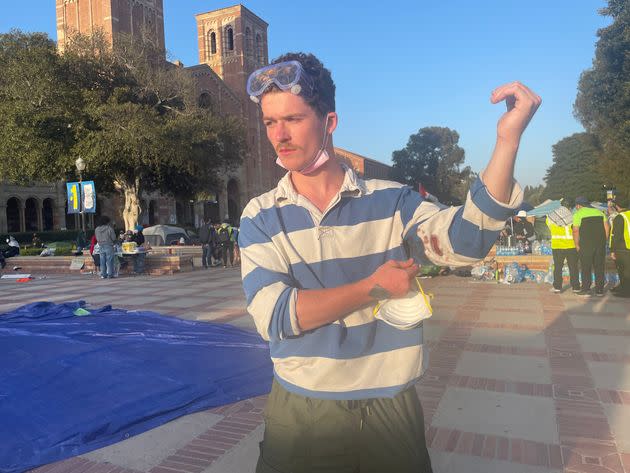
Several protesters said the counter-protesters appeared too old to be college students and that they shouted racist, homophobic slurs and threats of rape. One protester’s mother, who was at the encampment Wednesday, said counter-protesters called her son shahid, an Arabic word for martyr, and threatened to physically hurt him.
“The students were great at de-escalating” and “did not respond in kind,” Açiksöz said on Wednesday. “It speaks volumes about their composure and commitment to nonviolence, even in the face of absolute violence.”
“What is happening at UCLA right now is a strategy that I recognize from Turkey,” Açiksöz tweeted at the time of the counter-protesters’ attack. “The police outsourcing violence to fascist mobs.”
“I compared it to Turkey because this was something that I experienced, personally, many times during my years of student activism,” Açiksöz said in an interview on Thursday. “You have groups of ultra-nationalists or classical fascists attacking students while the police is present and doing nothing. And then the police come and sweeps up and arrest the students who are attacked, rather than arresting the attackers themselves.”
“This is the playbook of authoritarianism everywhere, from Egypt to Israel to Turkey to India.”
The LAPD reportedly intervened after nearly three hours. The police department made no arrests and used no force, it said on X, formerly known as Twitter. UC President Michael Drake reported that 15 people were injured, although protesters say the actual number was higher.
On Wednesday, 398 UCLA faculty members, as well as 680 faculty and staff members from other University of California campuses, issued a letter to Block demanding that there be no police or disciplinary action against students participating in pro-Palestinian demonstrations. The California Federation of Teachers and some faculty at UCLA have called for Block to immediately resign for his “failure of leadership.” Block is set to retire in July and is one of three university leaders summoned to testify before Congress this month about antisemitism on college campuses.
Before the counter-protesters violently clashed with people in the encampment on Tuesday, the group had installed a large video screen facing the encampment that played loud footage from the Oct. 7 Hamas attacks all day and night.
The jumbo screen was part of a pricey counter-protest from an organization called The Bear Jews of Truth. According to two separate GoFundMe pages, the organization raised more than $133,000 in donations to erect the video display at UCLA and bring similar screens to other universities across the country. One of the pages says the group plans to bring a large screen to George Washington University in the District of Columbia in May.
An archived version of one of the fundraising pages shows plans to bring “something very big for the ucla encampment.”
“We are working to bring a huge screen and big loud speakers right next to them and just play nonstop clips and interviews from Oct. 7,” the page said.
The pro-Israel counter-protest has been supported by celebrities including comedian Jerry Seinfeld and his wife, Jessica Seinfeld, a cookbook author, as well as billionaire hedge-fund investor Bill Ackman, according to the Daily Beast.
Students within the encampment told HuffPost the video screen was a “form of torture” and reported a number of other tactics leveraged by the counter-protesters on Tuesday night, including launching fireworks, creating louds noises that sounded like gunshots and incessant cellphone alarms.
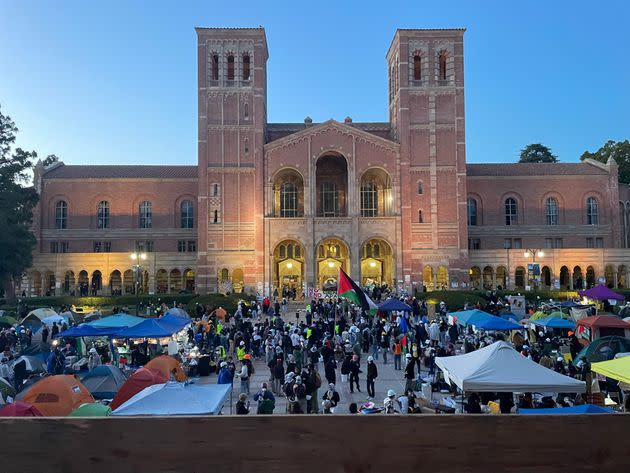
‘We’re Just Kids’
The UCLA administration canceled classes on Wednesday, and protesters spent the morning cleaning up the encampment and repairing the barriers around the site. A volunteer medic provided treatment for protesters injured the previous night. Participants also passed out goggles, helmets, ear plugs and gloves as rumors circulated that police intervention was imminent.
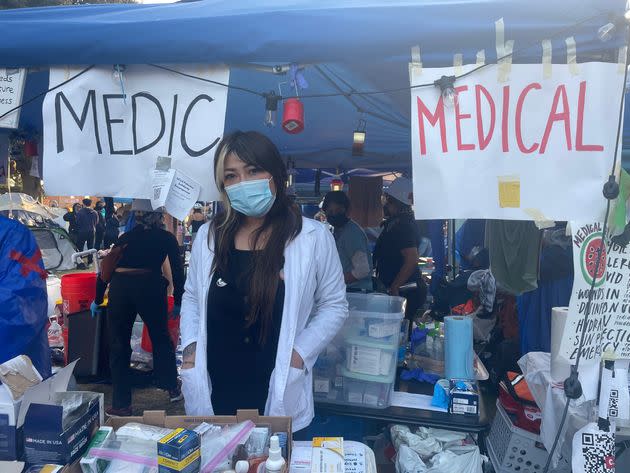
By Wednesday evening, a heavy police presence surrounded the perimeter of the encampment. Protesters barricaded the doors to Royce Hall, from which they anticipated police officers might enter. A group of faculty members lined up in front of the doors to form a human barrier to protect the students.
Encampment participants were organized into red, yellow and green categories, based on their willingness to risk arrest. Organizers made sure that participants who could not risk arrest were positioned close to exits and that those who planned to stay until removed had protective equipment.
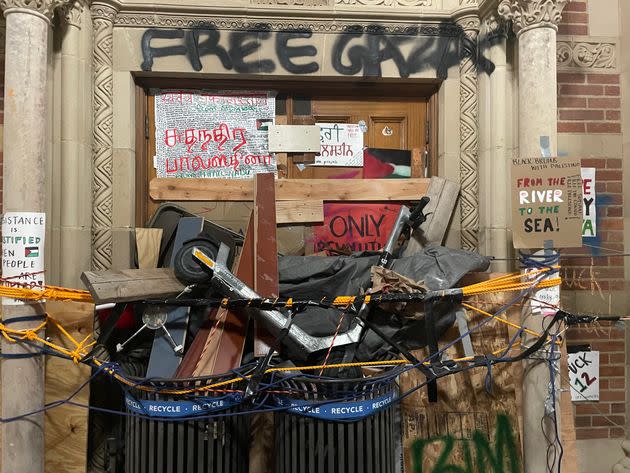
The standoff lasted for hours, with periodic dispersal orders blaring over a loudspeaker. Some protesters, many of whom had barely slept the previous night, suspected that police were waiting until the middle of the night to enter the encampment, hoping people would get tired and leave.
In the early hours of Thursday morning, police launched a multi-front operation into the encampment, using flash-bang devices and so-called “less-lethal” bullets against students who were armed with makeshift shields and umbrellas. Although protesters pushed back initial incursions from officers, the camp was fully cleared by morning.
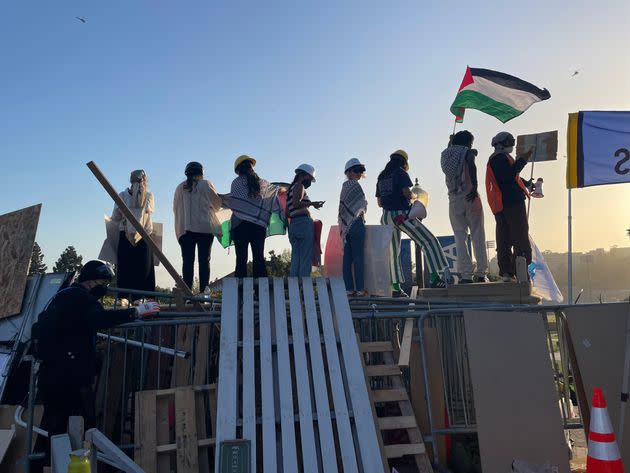
“The police attacked not only the encampment but students all over the campus,” Açiksöz said. “There were groups of students, maybe 1,000 students or so, surrounding the encampments in different directions, and everywhere that I went, I saw students being chased by stun grenades and batons.”
By Thursday morning, hundreds of students and faculty had been arrested and were being released from detention at the Inmate Reception Center and the Metropolitan Detention Center in downtown Los Angeles. The released protesters were greeted by public defense attorneys and family members, and by jail support volunteers who passed out bagels and coffee.
Los Angeles Public Defender Ricardo García said in a statement that his office was providing “on-the-ground support to arrestees” but that it was not yet clear what charges, if any, would be presented.
LAPD and the California Highway Patrol referred questions to the UCLA Campus Police, which did not respond to a request for comment.
Block, the UCLA chancellor, released a statement to the UCLA community Thursday afternoon about the decision to direct campus police and outside law enforcement to help clear the encampment after the administration failed to reach an agreement with encampment leaders.
“In the end, the encampment on Royce Quad was both unlawful and a breach of policy. It led to unsafe conditions on our campus and it damaged our ability to carry out our mission,” Block wrote. “It needed to come to an end.”
Later Thursday, in an alumni town hall, Block acknowledged the protesters’ demands but did not signal any willingness to meet them. He also said that UCLA’s commencement ceremonies will go forward, though he expects some disruptions.
Outside the Inmate Detention Center on Thursday morning, students walked outside red-eyed from lack of sleep and tear gas that still stung their eyes. One 21-year-old psychology major who was released Thursday said that the last two days on campus were like a “war zone” and that she witnessed police removing people’s hijabs and masks, and forcing students to walk by the video screen put up by pro-Israel counter-protesters on their way to arrest.
“They did this on purpose,” she said. “They told us, ‘Let’s do a media walk.’ It was a kind of a threat meant for public humiliation.”
She was one of a few hundred students, faculty and staff remaining at the encampment at 5:50 Thursday morning, eager to keep the police out of the encampment. She recalled how officers kettled her classmates, pushing through their makeshift barriers with batons and shields.
“We’re just kids,” she said. “We didn’t have much to go off of.”
Later Thursday, the encampment had been cleared by the university, and dozens of tent-shaped patches of grass marked what had been the makeshift solidarity encampment.
Some protesters talked about rebuilding the community, and others expressed caution.
“I think it’ll come back,” said a senior bioengineering major who was arrested Thursday morning. He received a concussion after being struck on the head twice Tuesday and pepper-sprayed in the eye.
“We just want our demands to be met. We want the university to step up and acknowledge that and be open about how they’re spending their money.”
